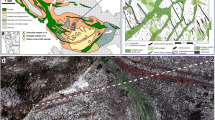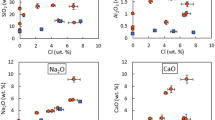Abstract
Fluid activity ratios calculated between millimeter- to centimeter-scale layers in banded mafic eclogites from the Tauern Window, Austria, indicate that variations in a H 2 O existed between layers during equilibration at P approximately equal to 2GPa and T approximately equal to 625°C, whereas a CO 2 was nearly constant between the same layers. Model calculations in the system H2O−CO2−NaCl show that these results are consistent with the existence of different saturated saline brines, carbonic fluids, or immiscible pairs of both in different layers. The data cannot be explained by the exisience of water-rich fluids in all layers. The model fluid compositions agree with fluid inclusion compositions from eclogite-stage veins and segregations that contain (1) saline brines (up to 39 equivalent wt. % NaCl) with up to six silicate, oxide, and carbonate daughter phases, and (2) carbonic fluids. The formation of crystalline segregations from fluid-filled pockets or hydrofractures indicates high fluid pressures at 2 GPa; the record of fluid variability in the banded eclogite host rocks, however, implies that fluid transport was limited to local flow along individual layers and that there was no large-scale mixing of fluids during devolatilization at depths of 60–70 km. The lack of evidence for fluid mixing may, in part, reflect variations in wetting behavior of fluids of different composition; nonwetting fluids (water-rich or carbonic) would be confined to intergranular pore spaces and would be essentially immobile, whereas wetting fluids (saline brines) could migrate more easily along an interconnected fluid network. The heterogeneous distribution of chemically distinct fluids may influence chemical transport processes during subduction by affecting mineral-fluid element partitioning and by altering the migration properties of the fluid phase(s) in the downgoing slab.
Similar content being viewed by others
References
Barnicoat AC (1988) The mechanism of veining and retrograde alteration of Alpine eclogites. J Metamorph Geol 6:545–558
Barrientos X (1991) Petrology of coexisting blueschists and greenschists, Ile de Groix, France: implications for preservation of blueschists. PhD Thesis, Harvard University, Cambridge, MA
Bebout GE (1991) Field-based evidence for devolatilization in subduction zones: implications for are magmatism. Science 251: 413–416
Bebout GE, Barton MD (1989) Fluid flow and metasomatism in a subduction zone hydrothermal system: Catalina Schist terrane, California. Geology 17: 976–980
Behrmann J, Ratschbacher L (1989) Archimedes revisited: a structural test of eclogite emplacement models in the Austrian Alps. Terra Nova 1: 242–252
Bowers TS, Helgeson HC (1983) Calculation of the thermodynamic and geochemical consequences of nonideal mixing in the system H2O−CO2−NaCl on phase relations in geologic systems: equation of state for H2O−CO2−NaCl fluids at high pressures and temperatures. Geochim Cosmochim Acta 47: 1247–1275
Chopin C (1984) Coesite and pure pyrope in high-grade blueschists of the western Alps: a first record and some consequences Contrib Mineral Petrol 86: 107–118
Cloos M (1984) Landward-dipping reflectors in accretionary wedges: active dewatering conduits? Geology 12: 519–522
Dachs E (1986) High-pressure mineral assemblages and their breakdown products in metasediments south of the Grossvenediger, Tauern Window, Austria. Schweiz Mineral Petrog Mitt 66: 145–161
Dachs E (1990) Geothermobarometry in metasediments of the southern Grossvenediger area (Tauern Window, Austria). J Metamorph Geol 8: 217–230
Eggler DH (1987) Solubility of major and trace elements in mantle metasomatic fluids: experimental constraints. In: Menzies MA, Hawkesworth CJ (eds) Mantle metasomatism. Academic Press, London, pp 21–41
Ellis DJ, Green DH (1979) An experimental study of the effect of Ca upon garnet-clinopyroxene Fe−Mg exchange equilibria. Contrib Mineral Petrol 71: 13–22
England PC, Holland TJB (1979) Archimedes and the Tauern eclogites: the role of buoyancy in the preservation of exotic eclogite blocks. Earth Plan Sci Lett 44: 287–294
Ernst WG (1990) Thermobarometric and fluid expulsion history of subduction zones. J Geophys Res 95: 9047–9053
Ferry JM (1976) A map of chemical potential differences within an outcrop. Am Mineral 64: 966–985
Ferry JM (1988) Infiltration-driven metamorphism in northern New England. J Petrol 29: 1121–1159
Ferry JM, Dipple GM (1991) Fluid flow, mineral reactions, and metasomatism. Geology 19: 211–214
Fisher D, Byrne T (1990) The character and distribution of mineralized fractures in the Kodiak Formation, Alaska: implications for fluid flow in an underthrust sequence. J Geophys Res 95: 9069–9080
Frank W, Hock V, Miller C (1986) Metamorphic and tectonic history of the Central Tauern Window. In: Flugel HW, Faupl P (eds) Geodynamics of the eastern Alps. Franz Deuticke, vienna, pp 34–54
Frank W, Miller C, Pestal G (1987) Geologische Karte der Republik Österreich: Matrei in Osttirol (1:50000). Geologische Bundesanstalt, Wien
Franz G, Selverstone J (1992) An empirical phase diagram for the clinozoisite-zoisite transformation in the system Ca2Al3Si3−O12(OH)−Ca2Al2FeSi3O12(OH). Am Mineral 77: 631–642
Franz G, Spear FS (1983) High pressure metamorphism of siliceous dolomites from the central Tauern Window, Austria. Am J Sci 283-A: 396–413
Gill JB (1981) Orogenic andesites and plate tectonics. Springer, Berlin Heidelberg New York Tokyo
Hickey RL, Frey FA, Gerlach DC, Lopez-Escobar L (1986) Multiple sources for basaltic are rocks from the southern volcanic zone of the Andes (34–41°S): trace element and isotopic evidence for contributions from subducted oceanic crust, mantle, and continental crust. J Geophys Res 91: 5963–5983
Hickmott DD, Sorensen SS, Rogers PSZ (1992) Metasomatism in a subduction complex: constraints from microanalysis of trace elements in minerals from garnet amphibolite from the Catalina schist. Geology 20: 347–350
Holland TJB (1979) High water activities in the generation of high pressure kyanite eclogites in the Tauern Window, Austria. J Geol 87: 1–27
Holland TJB (1983) The experimental determination of activities in disordered and short-range ordered jadeitic pyroxenes. Contrib Mineral Petrol 82: 214–220
Holland TJB, Ray NJ (1985) Glaucophane and pyroxene breakdown reactions in the Pennine units of the castern Alps. J Metamorph Geol 3: 417–438
Johnson EL (1991) Experimentally determined limits for H2O−CO2−NaCl immiscibility in granulites. Geology 19: 925–928
Kerrick DM (1990) The Al2SiO5 polymorphs. Mineral Soc Am Rev Mineral, vol 22
Kerrick DM, Jacobs GK (1981) A modified Redlich-Kwong equation for H2O, CO2, and H2O−CO2 mixtures at elevated pressures and temperatures. Am J Sci 281: 735–767
Krogh EJ (1988) The garnet-clinopyroxene Fe−Mg geothermometer —a reinterpretation of existing experimental data. Contrib Mineral Petrol 99: 44–48
Lammerer B (1986) Das Autochthon im westlichen Tauernfenster. Jahrb Geol Bundesanst Austria 129: 51–67
Luckscheiter B, Morteani G (1990) The fluid phase in eclogites, glaucophane-bearing rocks and amphibolites from the central Tauern Window as deduced from fluid inclusion studies. Tscherm Mineral Petrog Mitt 27: 99–111
McCaig AM, Knipe RJ (1990) Mass-transport mechanisms in deforming rocks: recognition using microstructural and microchemical criteria. Geology 18: 824–827
Miller C (1977) Chemismus und phasenpetrologische Untersuchungen der Gesteine aus der Eklogitzone des Tauernfensters, Österreich. Tscherm Mineral Petrog Mitt 24: 221–277
Morris JD, Leeman WP, Tera F (1990) The subducted component in island are lavas: constraints from be isotopes and B-Be systematics. Nature 344: 31–36
Morteani G (1974) Petrology of the Tauern Window, Austrian Alps. Fortschr Mineral 52: 195–200
Newton RC, Haselton HT (1981) Thermodynamics of the garnetplagioclase-Al2SiO5-quartz geobarometer. In: Newton RC, Navroisky A, Wood BJ (eds) Thermodynamics of minerals and melts. Springer, New York Berlin Heidelberg Tokyo, pp 131–147
Peacock SM (1990) Fluid processes in subduction zones. Science 248: 329–337
Perfit MR, Gust DA, Bence AE, Arculus RJ, Taylor SR (1980) Chemical characteristics of island-arc basalts: implications for mantle sources. Chem Geol 30: 227–256
Philippot P, Selverstone J (1991) Trace-element-rich brines in eclogitic veins: implications for fluid composition and transport during subduction. Contrib Mineral Petrol 106: 417–430
Raith M, Hormann PK, Abraham K (1977) Petrologic and metamorphic evolution of the Penninic ophiolites in the western Tauern Window (Austria). Schweiz Mineral Petrog Mitt 57: 187–232
Raith M, Mehrens C, Thole W (1980) Gliederung, tektonischer Bau und metamorphe Entwicklung der penninischen Serien im südlichen Venedigergebiet, Osttirol. Jahrb Geol Bundesanst Austria 123: 1–37
Rumble D (1978) Mineralogy, petrology, and oxygen isotopic geochemistry of the Clough Formation, Black Mountain, western New Hampshire, USA. J Petrol 19: 317–340
Ryburn RJ, Raheim A, Green DH (1976) Determination of the P, T paths of natural eclogites during metamorphism-record of subduction: a correction to a paper by Raheim and Green. Lithos 9: 161–164
Selverstone J (1986) Possible consequences of CO2−H2O immiscibility on blueschist-facies metamorphism. Geol Soc Am Prog Abstr 18: 745
Selverstone J, Munoz JL (1987) Fluid heterogeneties and hornblende stability in interlayered graphitic and nongraphitic schists (Tauern Window, eastern Alps). Contrib Mineral Petrol 96: 426–440
Selverstone J, Spear FS (1985) Metamorphic P-T paths from pelitic schists and greenstones from the southwest Tauern Window, eastern Alps. J Metamorph Geol 3: 439–465
Sisson VB, Crawford ML, Thompson PH (1981) CO2-brine immiscibility at high temperatures, evidence from calcareous metasedimentary rocks. Contrib Mineral Petrol 78: 371–378
Smith DC, Lappin MA (1989) Coesite in the Straumen kyaniteeclogite pod, Norway. Terra Nova 1: 47–56
Sobolev NV, Shatsky VS (1990) Diamond inclusions in garnets from metamorphic rocks: a new environment for diamond formation. Nature 343: 742–746
Sorensen SS (1988) Petrology of amphibolite-facies mafic and ultramafic rocks from the Catalina Schist, southern California: metasomatism and migmatization in a subduction zone metamorphic setting. J Metamorph Geol 6: 405–435
Sorensen SS, Grossman JN (1989) Enrichment of trace elements in garnet amphibolites from a paleo-subduction zone: Catalina Schist, southern California. Geochim Cosmochim Acta 53: 3155–3177
Spear FS, Franz G (1986) P-T evolution of metasediments from the eclogite zone, south-central Tauern Window, Austria. Lithos 19: 219–234
Sterner SM, Bodnar RJ (1989) Synthetic fluid inclusions-VII. Reequilibration of fluid inclusions in quartz during laboratory-simulated metamorphic burial and uplift. J Metamorph Geol 7: 243–260
Thomas S (1990) Segregations and veins in eclogite facies rocks from the Tauern Window, Austria: mineralogy and fluid inclusions. Geol Soc Am Prog Abstr 22:A257
Thomas S (1991) Zur Kluftbildung in Gesteinen der Eklogitzone (Hohe Tauern, Österreich). Technische Universität Berlin, PhD Thesis
Thomas S, Franz G (1989) Kluftminerale und ihre Bildungsbedingungen in Gesteinen der Eklogitzone/Südvenedigergebiet (Hohe Tauern, Österreich). Mitt Österr Geol Ges 81:189–218
Watson EB, Brenan JM (1987) Fluids in the lithosphere, 1. Experimentally-determined wetting characteristics of CO2−H2O fluids and their implication for fluid transport, host rock physical properties, and fluid inclusion formation. Earth Plant Sci Lett 85:497–515
Zimmermann R, Franz G (1989) Die Eklogite der unteren Schieferhülle, Frosnitztal/Südvenediger (Tauern, Österreich). Mitt Österr Geol Ges 81:167–188
Author information
Authors and Affiliations
Rights and permissions
About this article
Cite this article
Selverstone, J., Franz, G., Thomas, S. et al. Fluid variability in 2 GPa eclogites as an indicator of fluid behavior during subduction. Contr. Mineral. and Petrol. 112, 341–357 (1992). https://doi.org/10.1007/BF00310465
Received:
Accepted:
Issue Date:
DOI: https://doi.org/10.1007/BF00310465




